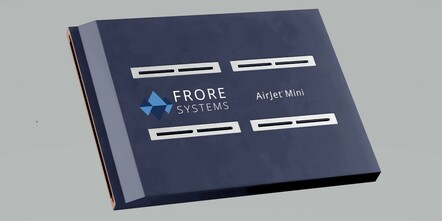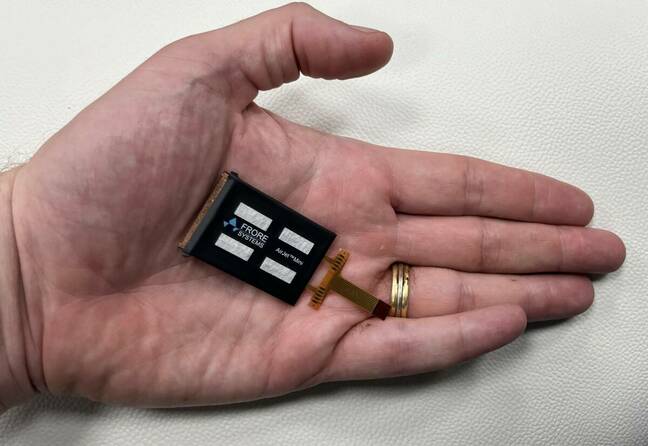WTF Is Solid State Active Cooling? Weve Just Seen It Working On A Mini PC
Computex A US upstart has developed a solid-state active cooling device not much bigger than an SD card that uses a variety of exotic technologies to suck heat out of small enclosed spaces.
Solid state what? And isn’t solid state stuff usually a source of heat? To unpack this, meet Frore Systems, manufacturer of said solid state active coolers named AirJet.
The 2.8 × 27.5 × 41.5mm widgets – imagine a slightly elongated SD card and you’ll get the picture – contain what the maker describes as “tiny membranes that vibrate at ultrasonic frequency.”
“These membranes generate a powerful flow of air that enters the AirJet through inlet vents in the top. Inside AirJet the air flow is transformed into high velocity pulsating jets,” states a company brochure [PDF].
That air is directed past a heat spreader at the base of each AirJet. As air passes through the AirJet it therefore acquires some heat from the device, then blows it away.
Frore said the AirJet mini needs a single watt to operate and carries away 5.25 watts worth of heat.
Frore is being cagey about the tech inside the AirJet, so caveat emptor. We were told the vibrating membranes are made with techniques similar to those used for production of semiconductors and screens – hence the “solid state cooler” description.
Frore execs wouldn’t tell The Register what the membranes are made of but did claim the biz employs physicists and material scientists, among other boffins – we even got a line that so many Frore staff hold PhDs its offices have more doctors than a hospital.
We were also told that the company includes aviation experts among its numbers, and that some of the AirJet’s workings are inspired by methods used to cool the leading edges of jet engine components.
- Since when did my SSD need water cooling?
- When it comes to liquid and immersion cooling, Nvidia asks: Why not both?
- Money starts to flow as liquid cooling gets hot in datacenters
- Europe wants more cities to use datacenter waste heating. How's that going?
Frore announced this week at the Computex 2023 exhibition in Taiwan that its first customer is Hong Kong's Zotac for its ZBOXI ZBOX PICO PI430AJ, a mini-PC that packs a 12th-gen Intel Core i3 and 8GB of RAM into a tiny 115 × 76 × 22mm chassis – slightly larger than a pack of cards.
Frore believes small is beautiful and hopes many more products will follow, selling the AirJet for tightly-packed devices in which passive heat management means lesser CPUs are deployed, or silicon is throttled back to avoid overheating. A very small active-cooling device, Frore argues, means designers can either use more powerful components and contain the heat they produce, or run CPU cores at higher intensity for longer.
Execs mentioned tablet computers as a prime target, along with fanless laptops. The Register checked out an AirJet retrofitted into a digital doorbell, a demo device chosen to demonstrate that cooler running could mean the chance to do more AI-infused video processing on the device.
Frore already has a professional model of the AirJet in the works and predicts it will dispel 10 watts worth of heat in the most advanced iteration. It also thinks it'll double performance with each generation of its tech (and cheekily refers to that improvement as "Frore’s Law"), but the folks we met at Computex are well aware AirJet won’t have sufficient capacity to make a difference to a server for years.
But execs think AirJet could have a role cooling SSDs or memory. Frore is aware of chatty workloads making SSDs run hot, and of rising memory-pooling standard Compute Express Link (CXL) likely leading to machines crammed full of RAM. They’re pondering a play to have AirJets on SSDs to cool arrays, or possibly on memory packages.
One factor limiting the tech is the need for an air intake. Frore is confident it can defeat dust, but never suggested the tech is waterproof. Smartphones may be off limits, for now.
And if this has all been done before, so be it. As Lester used to say, what of it? We thought this little gadget might be, ahem, cool enough to mention here on El Reg. ®
From Chip War To Cloud War: The Next Frontier In Global Tech Competition
The global chip war, characterized by intense competition among nations and corporations for supremacy in semiconductor ... Read more
The High Stakes Of Tech Regulation: Security Risks And Market Dynamics
The influence of tech giants in the global economy continues to grow, raising crucial questions about how to balance sec... Read more
The Tyranny Of Instagram Interiors: Why It's Time To Break Free From Algorithm-Driven Aesthetics
Instagram has become a dominant force in shaping interior design trends, offering a seemingly endless stream of inspirat... Read more
The Data Crunch In AI: Strategies For Sustainability
Exploring solutions to the imminent exhaustion of internet data for AI training.As the artificial intelligence (AI) indu... Read more
Google Abandons Four-Year Effort To Remove Cookies From Chrome Browser
After four years of dedicated effort, Google has decided to abandon its plan to remove third-party cookies from its Chro... Read more
LinkedIn Embraces AI And Gamification To Drive User Engagement And Revenue
In an effort to tackle slowing revenue growth and enhance user engagement, LinkedIn is turning to artificial intelligenc... Read more



